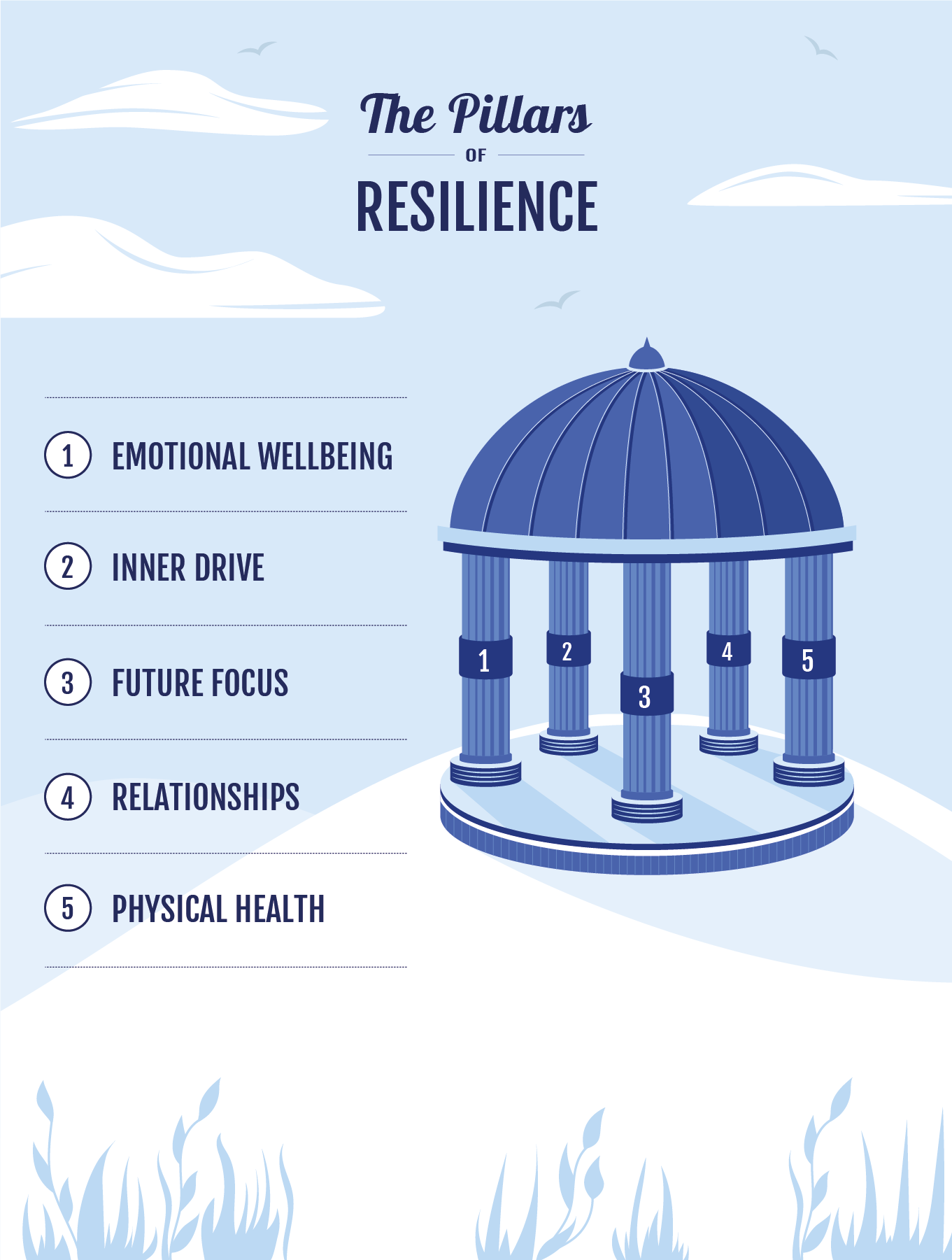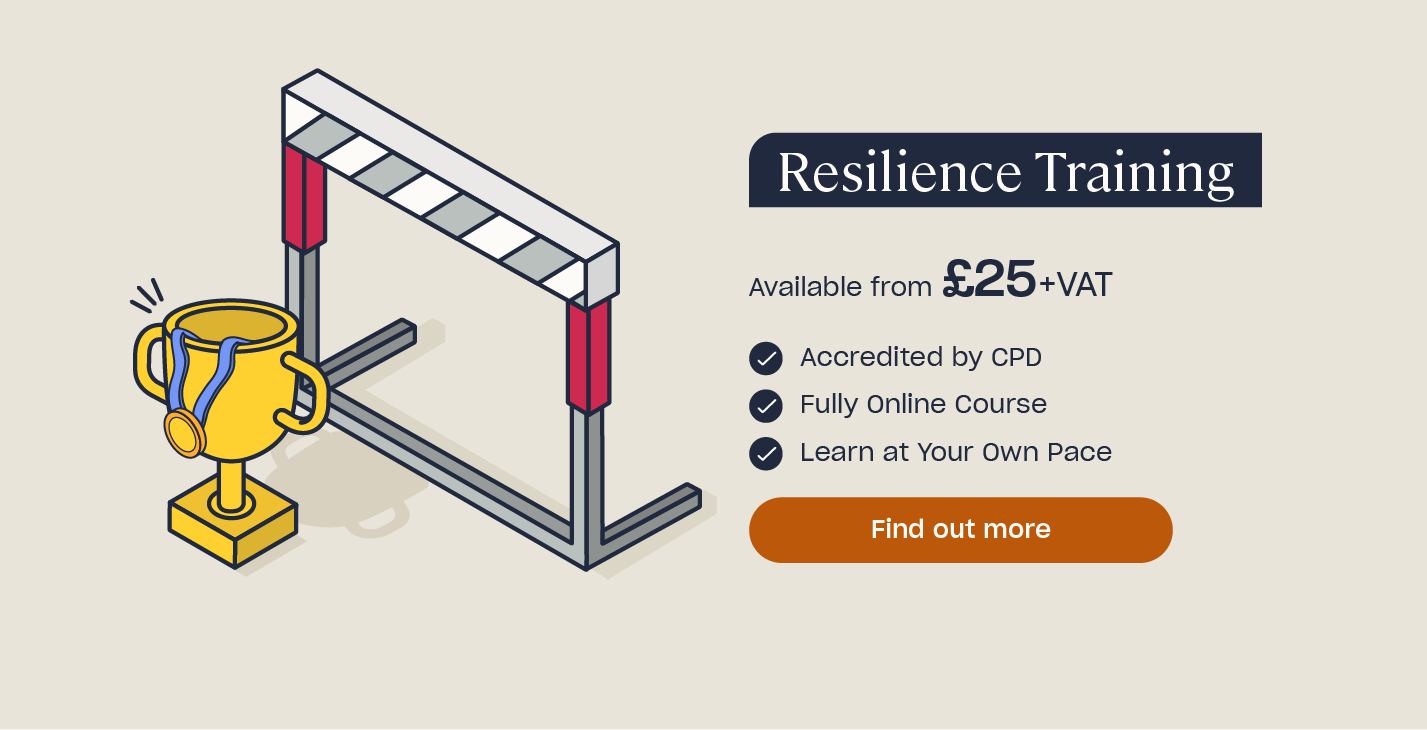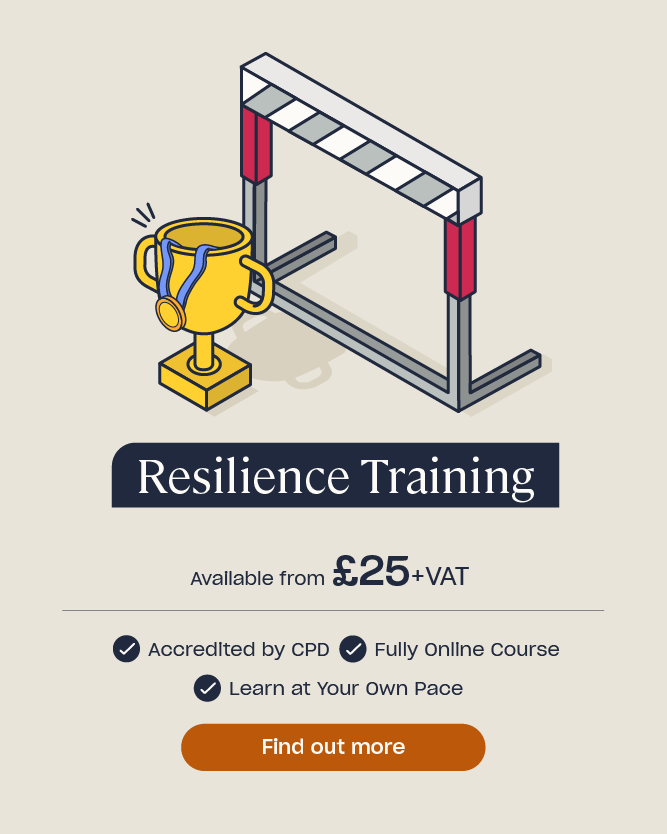Resilience in the Workplace: What are the Benefits and How Can Businesses Develop It?
Workplaces are often ever-changing and stressful environments, and the challenges they present can truly test a person’s tenacity. What’s interesting though is that some people not only comfortably ride out these waves of difficulty, but they even find success in them.
How do these people manage to make the most out of a bad situation? What prevents them from feeling personally affected when things don’t go the way they want or expect?
This quality is often defined as resilience.

How can you develop a resilient workforce and how can it benefit your businesses? This article will talk you through exactly what makes a person resilient and provide some practical steps for building resilience in the workplace.
This article contains the following sections:
- What is resilience?
- An example of resilience in the workplace
- Why is resilience important in the workplace?
- 9 benefits of resilience
- How can you build a resilient workforce?
- 8 tips for developing resilience in the workplace
Use the links above to jump to a certain section of the article.
What is Resilience?
Personal resilience refers to how effectively you handle difficult experiences in your life. It is often described as the ability to ‘bounce back’ and comfortably carry on in the midst of adversity. It also involves being able to effectively regulate your thoughts and emotions, as well as perceiving challenging situations as an opportunity, not a personal threat.
Most of us can identify a resilient person, but we might struggle to pin down exactly what makes them resilient. Is it their positivity? Well, it’s not as simple as that. It’s not the positivity that makes them resilient – it’s actually the other way around. Resilience enables a positive approach to work and outlook on life, which in turn enables better problem-solving and helps to maintain motivation.
It’s not just a reactive skill that switches on when a person faces challenges, however. It also enables a proactive approach to daily life. With a logic-orientated mindset and a focus on problem solving, general day to day tasks often feel more approachable to a resilient person.

Those with good resilience are therefore less vulnerable to getting knocked down by obstacles. They see unfavourable situations as an inevitable part of life, rather than an undeserved hindrance. They may even gain a sense of fulfilment from being able to work through them and grow.
An example of resilience in the workplace
Let’s say you’re producing a presentation. You’re including data from a few different reports and these are all located in different places across the company network. One of them hasn’t saved correctly and some of the pages are corrupted. A person with poor resilience may respond with deep frustration at how disorganised the information is. They may have thoughts along the lines of:
“Why does this always happen to me? Whoever did this is so thoughtless. I can’t believe I have to dig for all this information. It’s going to take me forever to get what I need.”

Conversely, a person with good resilience would likely feel some frustration, but only temporarily. Their thoughts would quickly shift away from taking it personally and onto finding a solution:
“This is such a mess. I wonder how it ended up like this. I should create a folder to organise these files and talk to the person who made the report. Hopefully we can try and recover the corrupted pages and figure out whether it’ll happen again. It’s going to take some extra time to put my presentation together now, but these things happen.”
Why is Resilience Important in the Workplace?
Having a resilient workforce benefits your business in so many ways, not least of all by making people more motivated, capable of dealing with change, and less susceptible to burnout. It also improves employees’ overall health, as resilience and wellbeing in the workplace are closely linked. Better mental health means less absenteeism and presenteeism, and in turn improves people’s performance throughout the workplace.

In fact, a study carried out by CV-Library revealed that 57% of employers see resilience as a key skill for candidates. Meanwhile, 71% viewed the ability to adapt as a key skill, which is a core aspect of resilience. These results reveal that businesses place high value on employees who demonstrate resilience.
Here are 9 benefits that resilience brings to the workplace.
1. Better handling of challenges.
Resilience can prevent negative emotions and thoughts from clouding judgement, meaning employees can deal with issues in the workplace more calmly and logically. When people focus on solving the problem rather than finding blame, they can reach a common ground and a constructive solution.

2. Improved communication.
Those with good resilience often have better self-assurance and confidence. They are more likely to actively speak up and contribute, and can express themselves more clearly and constructively. Idea-sharing in a business is crucial for exploring all options and encouraging creativity.

3. Reduced burnout and presenteeism.
People become burnt out when they lose that driving passion for their work. This is often linked to poor resilience. Burnout can then lead to presenteeism, which is when an employee’s mind isn’t fully switched on at work. Resilience can help people hold onto that spark for their job and bring their whole selves to it.

4. Creating a competitive business.
Businesses who can effectively ride out times of change, and who have employees that work well together, are the ones that will weather difficult times in their industry.

Also, resilient employees are more likely to stick around during and after changes. Holding onto people who know the business inside out and can tolerate necessary changes is important for the longevity of your organisation.
5. Setting realistic expectations.
Conflicting expectations are often due to a lack of clear communication and boundary setting. Resilience enables people to better understand their own and others’ needs, so expectations don’t go beyond people’s capabilities. This in turn allows everyone to work more efficiently and amicably.

6. Better relationships amongst colleagues.
A key aspect of resilience is building strong relationships with others, including colleagues, which enables better teamwork. Resilience can also prevent friction amongst colleagues, as it helps you to take things less personally.

7. Open to upskilling and developing.
After resilience and ability to adapt, the study by CV-Library revealed that almost 40% of employers value a willingness to adapt. Resilience promotes a growth mindset, where the person will actively and openly seek out development opportunities. Having employees in your team who are willing to grow in turn pushes the company to grow.

8. Good organisation and time management.
All workplaces benefit from having organised staff, as they can efficiently manage their workload and coordinate with others. Resilience can foster a mindset that focuses on the future and allows them to plan realistically, which promotes productivity.

9. Willingness to give and receive support.
A growth mindset enables an openness to feedback, both in terms of giving and receiving. Resilient employees see the value in reaching out to others, as no one is a one-man band. This can help them overcome challenges and receive valuable support during personal difficulties, which may otherwise have a knock-on effect at work.

As you can see, having a resilient team brings countless benefits. There are really no downsides to helping people become more resilient. But how can you do so?
Want to Learn More?
If you want to learn more about how to build personal or organisational resilience, consider taking our dedicated online Resilience Training course. It contains in-depth strategies and downloadable resources that enable ongoing growth and real, meaningful change.
How Can You Build a Resilient Workforce?
Building resilience is very much a personal journey that takes self-reflection, time, and practice. However, team leaders and managers can support an individual’s development by providing the right tools and training. Facilitating resilience from a senior level also promotes organisational resilience, making it a work-wide culture. This reassures and encourages staff to commit time for development.

With this in mind, here are 8 tips to help you and your team develop both personal and organisational resilience in the workplace.
1. Understanding the basic elements of resilience.
There are many views on what the key aspects of resilience are, and most do overlap. They can usually be boiled down to five key pillars, which are:
- Emotional wellbeing – how well you manage your emotions and thoughts, and how healthy and realistic your views are of yourself and the world. This is the most fundamental pillar of resilience.

- Inner drive – your ability to set goals and motivate yourself, as well as adopt a forward-thinking approach to progress through life.
- Future focus – your level of foresight, as well as an ability to focus on solutions and positive change. It also encompasses acceptance of failures and adversity.
- Relationships – having a strong social network with friends, family, colleagues etc., which provides emotional and physical support.
- Physical health – recognising the importance of looking after yourself physically, as poor physical wellbeing can directly impact the other pillars.
These are all interlinked and contain their own individual building blocks, which you must develop to strengthen the pillars as a whole. For example, one of the essential components of emotional wellbeing is understanding and regulating your thoughts.
By recognising how many different personal elements must be tended to, you’ll be in a good starting position to develop your and others’ resilience. It’ll enable you to identify areas that you or others already perform well in and those which need working on.
2. Analysing strengths and weaknesses.
A person can only effectively develop their resilience with self-reflection. They need to consider the pillars of resilience and identify which areas they need to work on. Giving and receiving feedback in the workplace can help tremendously with this.
Good opportunities for doing so include having frequent 121 sessions between managers and employees and prompting people to complete 360 feedback for everyone in their team. When people get in the habit of identifying their strengths and weaknesses, they learn how to focus on success and opportunities for growth. As a result, they’ll feel like nothing can stop them.
Now that you recognise the five key pillars of resilience and the importance of reflecting on them, here are a few suggestions for developing them.
3. Improving emotional wellbeing.
Building emotional resilience in the workplace takes time and a willingness to break out of deeply-rooted harmful habits. For example, negative automatic thoughts are a barrier to many people’s resilience. The best way to challenge these and improve your emotional resilience is with physical tracking and correcting.

An effective way you and others can do this is by writing down negative thoughts and analysing their validity. Ideally, you’ll do this as soon as you can after they occur. Over time, the mind will divert from automatically creating a detrimental thought to challenging it instead. Eventually, with practice, your mind will learn to ignore and replace negative thoughts with a healthier, more realistic one.
4. Promoting an inner drive.
Being self-driven is essential for finding greater success and productivity at work and preventing things from becoming overwhelming. Without it, people can often feel like projects are dragging and may not put their heart into them.
One way to enhance inner drive is through effective goal setting. One commonly used framework is SMART, which stands for specific, measurable, attainable, relevant, and time bound. Any tasks and projects that you and your team carry out should be checked against this SMART framework, as it helps to ensure they’re realistic and doable. Establishing clear-cut goals boosts a person’s inner drive and, with practice, will help maintain your motivation’s momentum.
5. Fostering a future focus.
Looking towards the future is a fundamental way to keep moving forward constructively and smoothly. You therefore need to know how to promote a growth mindset. Not only does this allow openness to change and adaptation, but it also allows healthy responses to unexpected challenges and problems.
Two areas you should look to develop in yourself and others is critical thinking and accountability. As a manager or senior member of staff, leading by example is an effective way to promote this in your team. Critical thinking requires stopping and thinking logically, rather than being swayed by emotions. It also means being open to admitting you don’t know everything and can ask questions to learn more.

Accountability means taking responsibility for your actions and emotions. It means recognising that you can’t change the past, but you can positively affect the future. Rather than waste time placing meaningless and potentially inflammatory blame, this allows you and others to take a forward-thinking approach to a situation and learn from it.
6. Developing healthy relationships.
Relationships take time to develop and really can’t be forced. However, the end result is feeling better understood, supported, and inspired by others, so it’s worth the effort. Three areas you should focus on at work are addressing toxic relationships, building genuine connections, and finding or becoming a role model or mentor.
If there are people who bring you and others down at work, think about what can be done. Often, people don’t fully realise what they’re doing and how it affects others until someone else challenges it. Feedback can help with this.
Building genuine connections is as simple as expressing real interest in others, including their differences, and being mindful of their views and values. Opening up your mind to how others live expands your own perceptions and can lead to fulfilling relationships in ways you never even expected.
Finding or becoming a role mentor is an excellent way to develop the core elements of resilience. You should therefore encourage your team to learn from those around them. This could be as simple as observing what they do from a distance or having more direct one on one discussions. In turn, let people know that you’re willing to support their growth and share your experiences with them.
7. Supporting physical wellbeing.
A person’s physical state is closely linked to their mental and emotional one, so it can have a huge knock on effect on how resilient a person feels. There’s only so much you can do to support this pillar in others, as physical fitness is very much a personal thing.

However, you can help people gain the physical and emotional rest they need by promoting a good work-life balance. There really is no reason for people to take work home with them. If they are, chances are the work hasn’t been organised properly and staff are being overworked. This is detrimental to productivity. When people come into work after a proper break, they’ll be much more switched on.
8. Providing personal / professional development planning.
As you’ve no doubt noticed by now, ongoing development is key to resilience. Team leaders are in an excellent position to encourage this. Therefore, you should fit in time to create a personal or professional development plan (PDP) together with your team members. Effective PDPs can help to prevent development from feeling overwhelming, as it often can feel daunting getting started.
You can find advice on creating a professional development plan in our dedicated guide, which also contains an example and template: Writing a Professional Development Plan – Example and Template. You might also want to take a look at our Coaching and Mentoring Course which is designed to give you the practical tools and techniques needed to get started with successful coaching and mentoring.
You can use PDPs for all the strategies listed throughout this guide. Setting clear and actionable steps can help the process of building resilience feel more tangible.
Resilience isn’t achievable overnight, but it is something that you should cultivate in your workplace. With the mindset and abilities that resilience brings, people can remain motivated, work well with others, and ride out times of difficulty and change. A resilient workforce can lead your business to successes that are often unattainable to those who struggle with natural challenges.
What to Read Next:
- What is EQ? A Guide to Emotional Intelligence in the Workplace
- The Importance of Upskilling Staff in Your Business
- A Personal Development Plan (PDP) Guide and Template
- Resilience Quiz
- How to Build Resilience in Healthcare Professionals
- What are Personal Development Goals for Work?
- Soft Skills in the Workplace
- Online Resilience Training Course








